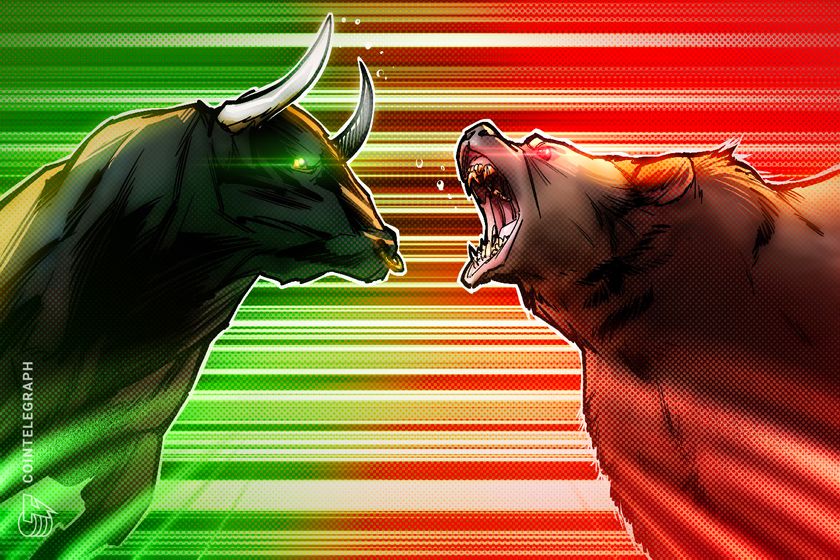Is it a bull or bear market? How to tell the difference



TL;DR:
Not sure if you’re in a bull or bear market? This guide breaks down how to spot the difference using price action, volume, sentiment and onchain data. Learn how to recognize market cycles, what signals to watch for and how to adjust your strategy for each phase so you can trade smarter.
Crypto markets can feel like emotional rollercoasters, prices soaring one month, then crashing the next. You’re not alone if you’ve ever wondered whether you are in a bull or a bear market.
In the simplest terms:
-
A bull market is when prices keep going up, people are excited and there’s a general sense that the future is bright. Think back to late 2020 and early 2021; Bitcoin (BTC) climbed from around $10,000 to nearly $70,000. New projects were launching daily and it felt like everyone from your cousin to your Uber driver was buying crypto.
-
On the flip side, a bear market is when prices drop consistently, investors pull back, and sentiment sours. A good example? 2022. After hitting all-time highs, the market tumbled. Bitcoin fell below $20,000, projects collapsed (remember Terra?), and even veteran traders started discussing “building in the bear.”
Knowing what kind of market you’re in helps you make smarter moves, and that’s why this all matters. You don’t want to ape into memecoins during a downtrend or panic-sell just before a rebound.
Recognizing market phases helps you invest more strategically, manage risk and crucially, keep your emotions in check. Which, in crypto, is half the battle.
Did you know? In 18th-century England, “bearskin jobbers” were early short-sellers, traders who sold bearskins they didn’t yet own, betting prices would fall. The saying “don’t sell the bear’s skin before you’ve caught the bear” stuck, and so did the metaphor. The term bull came later, not only as the bear’s opposite, but also because of the upward motion of a bull’s horns when attacking.
Understanding bull and bear markets
Sure, crypto is “numbers on a chart.” But, it’s also stories, headlines and entire communities’ constantly shifting mood. Here’s how to understand bull and bear cycles:
1. Bull market characteristics
a) Sustained price increases
Prices rise in a bull market, sure. What’s more important is that they keep rising, often over weeks or months. You’ll see major coins climbing steadily and altcoins riding the wave.
A textbook example? Bitcoin’s run in 2020–2021, where it jumped from ~$10,000 to $69,000. That rally had momentum, institutional backing (Tesla, Strategy, etc.), and serious retail FOMO.
Or Dogecoin’s meme-fueled sprint in early 2021, going from joke status to $0.45 thanks to Elon tweets and Reddit hype.
b) Positive investor sentiment
You’ll know sentiment is bullish when X feels euphoric, everyone’s calling for a BTC moonshot and new projects are launching daily with sky-high valuations. Money flows in fast, and even risky bets feel like obvious plays. That’s when you know that positive investor sentiment is in the air.
c) Favorable economic indicators
Bull runs often line up with low interest rates, easy access to credit and generally tech-friendly conditions. During the 2020 bull, for instance, pandemic-era stimulus checks and low borrowing costs gave retail and institutional investors more ammo to deploy into digital assets.
2. Bear market characteristics
a) Prolonged price declines
Bear markets will drag on until the cows come home. Prices fall, then fall some more, and every slight bounce is sold off. Think 2018’s “crypto winter,” when Bitcoin crashed from $20,000 to around $3,000.
Or 2022’s brutal downturn, when BTC dropped from $69,000 to under $20,000. That crash wasn’t really about price either; it was fuelled by implosions like Terra-Luna, Celsius and the FTX scandal. The dominoes just kept falling.
Bear markets tend to feel like the party’s over.
b) Negative investor sentiment
During bear phases, fear takes over. Headlines turn grim, social media goes quiet and even die-hard believers start questioning their convictions. Funding dries up, dev teams go silent and “exit liquidity” jokes make the rounds.
c) Adverse economic conditions
Macro headwinds don’t help. High interest rates, inflation fears or tightening monetary policy often make things worse. In 2022, for example, the Fed’s aggressive rate hikes made risk assets, including crypto, far less appealing.
Key indicators to identify market phases
While no single metric can give you 100% certainty, there are a handful of time-tested indicators that traders and analysts rely on. Let’s break down the indicators you can use, aside from the obvious one (price).
Trading volume
Volume tells you how much conviction is behind the price moves.
In a bull market, rising prices are often backed by strong trading volume. More buyers step in, more liquidity enters the market and the rally feels supported.
During a bear market, volume tends to dry up. Price drops are met with weak buying pressure and it can feel like no one wants to touch the market.
Low volume plus a declining price? Not a great sign if you’re hoping for a bounce.
Did you know? During the 2021 bull run, Dogecoin experienced a surge in trading volume, with nearly $70 billion traded in a single day as its price soared to $0.45
Market sentiment
One tool many investors rely on is the Crypto Fear & Greed Index. It measures social media activity, volatility, Google search trends and more to gauge whether investors feel optimistic (greedy) or pessimistic (fearful).
Extreme greed often pops up near the top.
Extreme fear tends to appear near the bottom, though it can hang around in deeper downturns.
Check it daily, but don’t let it drive your whole strategy. It’s a mood ring, not a crystal ball.
Technical indicators
You don’t have to be a chart wizard to spot a few helpful signals.
-
Moving averages: When the price is consistently above the 200-day moving average, it’s generally bullish. When it dips below, that’s often a warning sign. These are long-term trend indicators, not day-trading tools.
-
Relative strength index (RSI): This measures whether an asset is overbought or oversold: Readings above 70 suggest it’s overheated and due for a pullback, while readings below 30 may indicate it’s oversold with potential to bounce.
None of this is gospel, but it helps you get a feel for momentum.
Fundamental factors
Sometimes the biggest market movers don’t show up on a chart.
Bullish signs might include:
-
Big-name institutional adoption (like BlackRock applying for a Bitcoin ETF).
-
Friendly regulatory news or court wins for crypto firms.
-
Major tech milestones (think Ethereum upgrades or layer-2 rollouts).
Meanwhile, bearish signs often look like:
-
Regulatory crackdowns (the SEC targeting major exchanges).
-
High-profile security breaches or protocol failures.
-
Global instability — inflation, war or financial contagion.
Once you know what to look for, the next step is figuring out where. Fortunately, crypto comes with a treasure trove of free tools if you know where to dig.
Charting platforms
If you want to understand price action, you need solid charts.
-
TradingView is known for customizable charts and technical indicators.
-
Cointelegraph offers clear overviews of prices, market caps and volume trends that are especially useful for tracking newer or smaller tokens.
Did you know? TradingView’s charting tools are integrated directly into many of the world’s top crypto exchanges, including Binance, Bybit, OKX, and Bitget.
Sentiment analysis
Crypto is more mood than math.
Tools like LunarCrush track social media activity, influencer buzz and trending tokens. If Dogecoin starts heating up again, you’ll probably see the early signs there.
Onchain data
Want to know what the whales are doing? Platforms like Glassnode and CryptoQuant surface data like wallet flows, miner activity and exchange balances. It’s like reading the blockchain’s heartbeat. You’ll often spot capital shifts before they show up in the price.
Strategies for navigating different market conditions
Understanding the cycle is one thing. Knowing how to act on it is another. Your playbook should change depending on whether you’re riding a bull or surviving a bear.
Bull market strategies
-
Trend following: When the market’s running hot, sometimes the best move is to go with the flow, but stay disciplined. Focus on assets in strong uptrends, and don’t get caught chasing green candles without a plan.
-
Profit-taking: Set targets and honor them. It’s easy to get greedy when everything’s pumping, but taking profits on the way up helps you avoid the dreaded round trip: watching your gains vanish in the next drawdown.
-
Risk management: Even bull markets pull back. Use stop-losses or trailing stops to lock in gains and guard against surprise reversals. You’ll thank yourself later.
Bear market strategies
-
Defensive positioning: Sometimes, the smartest trade is no trade. Moving part of your portfolio into stablecoins or sticking to less volatile assets like Bitcoin and Ether (ETH) can help preserve capital while others panic.
-
Dollar-cost averaging (DCA): Trying to time the exact bottom? Good luck. DCA smooths the ride by spreading your entries over time, lowering your average cost and helping you stay engaged without overcommitting.
-
Focus on fundamentals: Bear markets strip away the noise. What survives are the projects with real use, strong teams and long-term vision. If you’re holding through a downturn, ensure you’re holding for the right reasons.
By failing to prepare, you are preparing to fail
Bull or bear, crypto never stops moving, but that doesn’t mean you have to react to every swing. Price trends, sentiment shifts, volume patterns and fundamentals can all clue you in on where you are in the cycle. Armed with the right tools and a calm mindset, you can tune out the noise and act with clarity.
Markets reward preparation, and knowing whether you’re in bull territory or bear country is one of the most powerful tools you can have.
Happy trading!
This article does not contain investment advice or recommendations. Every investment and trading move involves risk, and readers should conduct their own research when making a decision.








